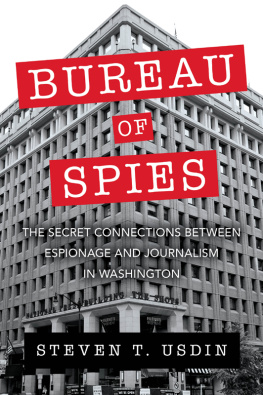SPIES AND
SECRET SERVICE
THE STORY OF
ESPIONAGE, ITS MAIN SYSTEMS
AND CHIEF EXPONENTS
By
HAMIL GRANT
First published in 1915
Copyright 2020 Read & Co. History
This edition is published by Read & Co. History,
an imprint of Read & Co.
This book is copyright and may not be reproduced or copied in any
way without the express permission of the publisher in writing.
British Library Cataloguing-in-Publication Data
A catalogue record for this book is available
from the British Library.
Read & Co. is part of Read Books Ltd.
For more information visit
www.readandcobooks.co.uk
Contents
WORLD WAR O NE ESPIONAGE
I THE ETHO S OF THE SPY
II THE SPY THRO UGH THE AGES
III LE CARON
IV SCHULMEISTER
V NATHAN HALE
VI MACK AND THE MO LLY MAGUIRES
VII MAJOR ANDR
VIII BRITISH SE CRET SERVICE
IX FRENCH SE CRET SERVICE
X GERMAN SE CRET SERVICE
XI GERMAN SECRET SERVI CE Continued
XII GERMAN SECRET SERVI CE Continued
XIII GERMAN SECRET SERVI CE Continued
XIV GERMAN SECRET SERVI CE Continued
XV GERMAN SECRET SERVI CE Concluded
XVI DIPLOMATIC, SOCIAL, CHURCH SPIES
XVII AMERICAN SE CRET SERVICE
XVIII NAPOLEON, HIS MISTRE SS ANDA SPY
XIX CONCLUSION BIBLIOGRAPHY
Illustrations
Fouch
He nri Le Caron
The Duchess o f Portsmouth
Frederi ck the Great
The Che valier d'Eon
WORLD WAR ONE
ESPIONAGE
The subject of espionage during World War One is a fascinating area, with as many twists and turns as the reader could expect. Contrary to popular beliefs and media depictions however, the reality of early espionage was on a surprisingly small scale. The relationship between Britain and Germany is possibly the best example of the confusion, paranoia and suspicion which gripped the general public. Spies were located in all the major protagonists countries (and colonies), especially in America, Russia, France, India and the Middle East. But Spy Fever as it was commonly known, held Britain in particular, to such an extent that naturalised German citizens were interned in camps. A 1918 petition demanding the internment of all naturalised ex-Germans attracted over a million signatures. The hidden hand of the enemy in our midst became an obsession for the populace, press and government alike. During the entirety of the war however, British counter-espionage only succeeded in locating t hirty spies.
At the turn of the twentieth century, Britain and Germany viewed each other as friends, discussing a formal alliance as late as 1901. Fear and suspicion gradually came to dominate the public sphere and international relations though, with the growing military threat of Wilhelmine Germany creating a climate where popular novels about espionage thrived. Writers such as Erskine Childers, with The Riddle of the Sands (1903) and William Le Queuxs The Invasion of 1910 (1906) Spies of the Kaiser (1909) depicted sophisticated German intelligence networks, laying the foundations for an invasion of Britain. As Le Queux concluded, What will happen? When will Germany strike? Who knows?
Espionage and invasion novels such as these tapped into a massive wave of paranoia in the British public. Sixty such novels were published between 1871-1914, with two thirds of these identifying Germany as the threat. Of the thirty one published after 1900, only five wrote of invasions from other countries, and after 1904 this was solely Germany. Boys Own (a story paper aimed at teenage boys) in 1906 assured its million readers that most German tourists in Britain were spies, and this concept of an army of civilian spies entered the popular psyche. These concerns were not entirely fiction; a German spy was convicted in Exeter in 1911 and the British were doing exactly the same in Germany. In 1910 two British officers were convicted of espionage whilst walking around German naval installations their luggage full of notes and photographs.
In a climate such as this, when World War One broke out, accusations were rife. Lord Northcliffes Daily Mail ran a campaign against German clerks working in Britain, printing many worried letters from its readers. The clerks were all identified as acting as spies on behalf of German industry, and this theme was re-repeated throughout the war. The government themselves became one of the most important centres of anti-German propaganda, with bodies such as the Parliamentary Recruiting Committee (1914) and the National War Aims Committee (1917) propagating Germanophobia. On the front (and at home) hundreds of homing pigeons were killed, to stop their use carrying messages to the enemy, and thousands of accounts of suspicious night-signalling were received, by which German spies were thought to be guiding Zeppelins or submarines to their targets. The metropolitan police received 9,000 reports of suspected espionage in the first three months of the war, but only in about 90 cases was the suspicion of espionage sufficiently strong to warrant detention.
During the course of the entire war, counter-espionage brought thirty-one German agents to trial, of whom 12 were executed. These figures were closer to the truth, and there was only a very small number of spies (largely employed by the German navy) active overseas. Britains own attempts to establish a spy network in Germany met with similarly little success. Despite the small-scale reality, on 13th May 1915, the Asquith government decided to intern all enemy aliens (mostly German citizens) residing in Britain for the duration of the war. Under Gustav Steinhauer (a German naval intelligence officer), the men actively employed in espionage were often untrained and inept amateurs. This is nowhere more sadly reflected than in the story of Carl Hans Lody, the first wartime spy to be executed in Britain.
Lody (alias Charles A. Inglis) was positioned in Edinburgh, where he successfully aided the sinking of the HMS Pathfinder; the first ship ever sunk by a torpedo fired from a submarine. After this success, Lody started writing his letters in German however, leading authorities to become understandably apprehensive. He was caught after being shadowed in Ireland, and executed on November 6th in the Tower of London. This was the first person, since the Jacobite rebel Lord Lovat (beheaded in 1747) to be executed in the Tower. A more successful spy was the infamous Wilhelm Franz Canaris, a German admiral, and later chief of the Abwehr from 1935-1944. Aged twenty-six, Canaris served aboard the SMS Dresden as an intelligence officer, and due to his excellent deception tactics, helped it evade the British fleet during the Battle of the Falkland Islands (the only one to do so). Canaris also survived a subsequent British assassination attempt in Spain, and carried on his espionage and naval career ac ross Europe.
The case of Marti Hari is perhaps one of the most interesting examples of World War One espionage; an exotic Dutch performer and dancer who moved to Paris in 1903. Hari travelled all over Europe during the war, arousing suspicion with her border crossing activities. When travelling by steamer from Spain, she was captured at the port of Falmouth and interrogated at length by Sir Basil Thomson (assistant commissioner at New Scotland Yard). Here, Hari admitted to working for French intelligence. In January 1917 however, the German military attach in Madrid transmitted radio messages to Berlin, describing the helpful activities of a German spy, code-named H-21. The French were thereby able to identify H-21 as Marta Hari (using the code-breaking of the British Room 40 team), and executed her by firing squad in October 1917. Frederick Fritz Joubert Duquesne is equally intriguing, known as the man who killed Kitchener, he claimed to have sabotaged and sunk HMS Hampshire, on which Lord Kitchener was en route to Russia in 1916. Forensics of the ship do not support this claim though, and it has been a matter of controversy ever since.














